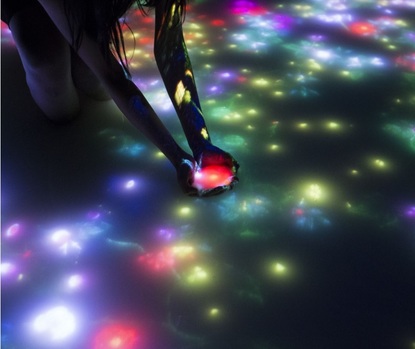| Founded in 2001, teamLab is an artistic collaboration with over 400 members, bringing together professionals from various fields of practice in the information age. The interdisciplinary group work to produce completely immersive environments using digital technology. They weren’t immediately well received in the art world, but since 2011 they have exploded onto the international scene, exhibiting in Japan, the USA, France, Australia, Turkey and just last year, the UK. I speak to Takashi Kudo about digital technology's important role in promoting positive relations between people. |
‘teamLab believes that digital technology can expand art and that digital art can create new relationships between people’
Interactivity between viewer and art is integral to your work - how important do you think it is to interact and fully immerse audiences in the 21st century?
With interactive art the viewer's presence and behavior change the work. The boundary line between the viewer and the work becomes blurry; the viewer actually becomes part of the art. This relationship is then no longer between the work and an individual, but between the work and a group of participators. It suddenly becomes important what the person next to you is doing. In this way, our works can affect the relationships between the people involved in the viewing process. If you were viewing a traditional painting this wouldn’t be the case – conversely, the presence of others might be considered an obstruction. If you were alone at an exhibition, you would probably think of yourself as lucky. However, with our work, we think you will find the presence of others more positive. If the change in the art caused by the presence of others is beautiful, then the very presence of those people can become beautiful too.
Not only in art, but in modern cities, people generally find the presence of others to be unpleasant. Being surrounded by others, whom we can neither understand nor control, is something we have to accept and put up with. This is because the city is static, unchanged by our presence or the presence of others. If we were to wrap the city entirely in the type of digital art conceived of by teamLab, we believe that the presence of others might become a positive one; it would be evident that people can contribute to the space rather than take from it.
In that sense, we believe that teamLab's digital art has major potential for expansion and growth in cities. Our current exhibition ‘Future World’ in Singapore is, as the name suggests, a world of the future, created in a museum.
With interactive art the viewer's presence and behavior change the work. The boundary line between the viewer and the work becomes blurry; the viewer actually becomes part of the art. This relationship is then no longer between the work and an individual, but between the work and a group of participators. It suddenly becomes important what the person next to you is doing. In this way, our works can affect the relationships between the people involved in the viewing process. If you were viewing a traditional painting this wouldn’t be the case – conversely, the presence of others might be considered an obstruction. If you were alone at an exhibition, you would probably think of yourself as lucky. However, with our work, we think you will find the presence of others more positive. If the change in the art caused by the presence of others is beautiful, then the very presence of those people can become beautiful too.
Not only in art, but in modern cities, people generally find the presence of others to be unpleasant. Being surrounded by others, whom we can neither understand nor control, is something we have to accept and put up with. This is because the city is static, unchanged by our presence or the presence of others. If we were to wrap the city entirely in the type of digital art conceived of by teamLab, we believe that the presence of others might become a positive one; it would be evident that people can contribute to the space rather than take from it.
In that sense, we believe that teamLab's digital art has major potential for expansion and growth in cities. Our current exhibition ‘Future World’ in Singapore is, as the name suggests, a world of the future, created in a museum.
How does the team dynamic work?
We work together and develop ideas in tandem. We emphasize not simply the process of manual production, but new discoveries during the creative process, and re-utilize those ideas as a group in an abstract and ubiquitous fashion.
We believe in the possibilities that group production poses, so we want to explore collaboration over solitary production. When we launched teamLab in 2001, we chose the name because we wanted to create a place for the group production of work as a sort of "laboratory."
Do you enjoy using the ceiling, walls and floor within your work - do you find digital art liberating in this way?
Exploring physical space using digital technology is key to our practice. The subject, which is mediated by the digital, is not necessarily the self - it may instead be another person - or the self ambiguously contained within a group. We want to make something that is able to be used by a number of people in the same space. By expanding space using digital art, we think that an effect can be made indirectly on the relations of people in the same place.
Do you think technology has a responsibility to change the world for the better?
We started this journey because we believed that digital work has the potential to expand the concept of art as we know it. Digital technology can help us understand what this world is about and change our thinking. By exploring the relationship between digital art and people, we can rethink how our world ought to be. We want to use art to change our values system and lead humanity on a positive trajectory.
What is it about the collaboration between art and technology that you think will improve mankind?
Digital art focuses on “bestowing change on the relations of people in the same space”. Creative acts are typically seen as personal activities, but digital art has the ability to create a place to enjoy mutual creativity. Through digital art, we can pay more attention to the positive part of making something with another person.
Can you tell me a little about last years 'flutter of butterflies beyond borders’ work at London’s Saatchi gallery?
In the interactive work, Flutter of Butterflies Beyond Borders, the patterns on the butterflies’ wings transform as they fly through space. As the work progresses, the butterflies fly seamlessly into the nearby installations, dissolving the concept of the artwork’s frame, and eliminating the boundaries between the works. This process ultimately creates an all-encompassing interactive installation.
The flight pattern of the butterflies is influenced by the state of the other works, as well as the behavior of the viewers: the butterflies gather in places where flowers bloom in the other works; and if a viewer touches a butterfly, it loses its life.
The artwork is created in real time by a computer program. The images are not pre-recorded or played back. The entire work continuously changes and the same state is never repeated.
What aspirations do you have for the future?
We intend to create large-scale works with the eventual aim of creating a teamLab amusement park where visitors can be immersed in large-scale art. By harnessing the power of digital art we hope to change the relationship between people inhabiting the same space, we hope to someday expand the scope of the work all the way to the scale of a whole city in order to change the relationship between city residents. We would love to be able to construct an entirely new city.


 RSS Feed
RSS Feed
